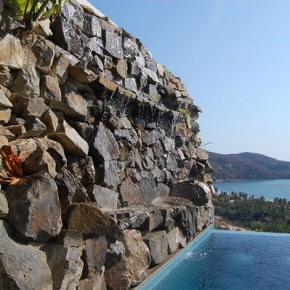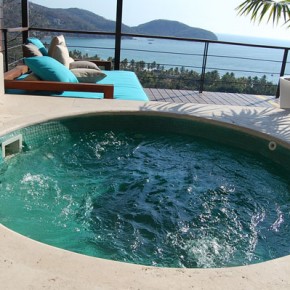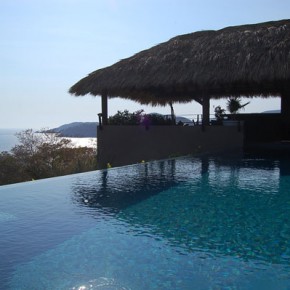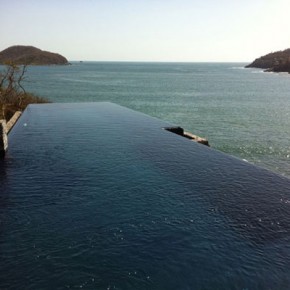Water has been used for thousands of years to add beauty and symmetry to architectural design…
The simple pleasure we receive gazing upon water, taking a cool refreshing dip or listening to its gentle trickle makes it a desirable element in home design. Whether in the form of a swim pool, Jacuzzi, fountain, cascade or pond, water gives us the sense of order, control over the uncontrollable.
In Zihuatanejo, the inclusion of water is paramount in local architectural design. Reflective and infinity pools are practically a trademark of exclusive resorts and dramatic private residences that are either beachfront or delicately balanced on precipices overlooking the Pacific. Skillfully crafted and illuminated water gardens, pools, ponds and cascades are all a common theme in Mexican coastal design.
Infinity pools
Probably the most recognizable water feature in Zihuatanejo is the infinity swimming pool. This type of pool has a zero or vanishing edge, which creates an illusion of water extending out to the horizon. Dramatically photographed in countless advertisements, journals and coffee table books, the infinity pool remains a highly desired and sought after element of local architectural design.
Infinity pools can be designed as both in ground or stand alone structures. Extensive and costly structural and hydraulic engineering is required to create an infinity pool; generally limiting its construction to upscale resorts and private residences. However, the dramatic visual of an infinity pool spectacularly illuminated at sunset makes the cost of construction pale in comparison.
Alternative to the infinity swimming pool is the dip pool or jacuzzi which produces a similar visual effect but costs much less to design and construct. Dip pools are ideal for homes with limited exterior space and can easily be added to a deck or terrace. They provide the appearance of water, allow for a refreshing dip and don’t require the amount of maintenance as a full sized swimming pool.
Water features
Water can also be used as a calming and meditative tool in landscape architecture. Creating water gardens, reflective pools, ponds, fountains and cascades are just a few ways to evoke relaxation and harmony throughout the home. Here, like in most coast regions where the idea of outdoor living is readily embraced, water features can be a way to bring the outside in and vice versa. Clever illumination and creativity in water feature design and construction is limited only to one’s imagination.
Materials
Overall, architects and designers prefer to use natural materials in their creation of water features. Polished and textured concrete, glass tile, rock, hardened earth and stone are most practical and aesthetically pleasing. Small Venetian tile is probably the most common finish for swimming, dip and jacuzzi pools. Venetian tiles have an iridescent glossy surface which creates an elegant appearance under water. Carved river rock and stone are typically used to create fountains and often used in the creation of salt-water pools. For in ground non-infinity swimming pools, textured concrete may be used as a non-skid surface around the edge of a pool while polished concrete may be used for the pool’s formation.
Illumination
Artistic illumination, either harnessed from natural daylight or produced by artificial lighting plays a key role in a water feature’s conceptual design. The entire form of water can be altered and enhanced by underwater lighting or the use of contrasting natural illumination such as cast sunlight and shadows.
Swimming pool elements
Swimming pools whether infinity or not can contain within them various elements such as stairs, bench seating, stools, etc. depending on their size and overall purpose. Seating areas close to the edge of a pool with an ocean view may be a consideration, especially for those wanting a front row seat at sunset. Carved out cup and umbrella holders, heating and jacuzzi jets are also useful details to include in pool design. It’s best to carefully plan out the design and installation of your pool as it will be difficult and costly to make changes or modifications later on.
Maintenance
Any and all water features require some degree of ongoing maintenance. Larger swimming pools, especially infinity pools require constant maintenance. Their hydraulic systems are more complex and must be handled and maintained by professionals who are well versed in proper care and servicing. Pool filters, vacuums and pumps must be cleaned regularly, as well as adding the proper mixture of chemicals to keep the water clean and aerated. Even small water features require regular attention. As this area is prone to both wet and dry seasons, both abundant rains and lack thereof can affect the functionality of a water filtration system. If a pool or fountain is left unchecked, filters and pumps can become damaged or clogged with debris. Employing professional technicians is imperative for keeping your pool, fountain or otherwise in tip-top shape.
Salt pools
Salt water pools can be a more eco-friendly alternative to the traditional chlorine treated swimming pools. Chlorine is produced through electrolysis by a chlorine generator, rather than having to treat the water with harsh chlorinated chemicals. Salt water is also softer on the skin and less of an eye irritant. It also tends to feel more refreshing than chemically treated pool water. From an economic standpoint, it can be less costly to own a salt water pool as the chlorine is produced by the salt itself rather than having to buy additional chemicals. Though salt water pools require less ongoing maintenance they are still not totally maintenance free.
- Infinity pool with cascade, Ensueño 10. Photo by Maura Taylor.
- Jacuzzi, Ensueño 10. Photo by Maura Taylor.
- Infinity Pool with bar seating, Ensueño 10. Photo by Maura Taylor.
- Infinity Pool, Villa Xiguacan. Photo by Maura Taylor.








